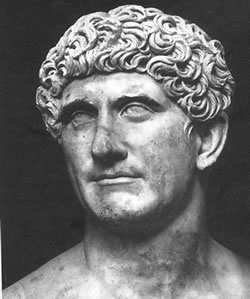Heston and Snell

A bust of Marc Antony, capturing his unguarded regret after Cleopatra dumped a bowl of Fetuccini Alfredo on the noble Roman's head for pinching a slave's buttocks.
Charlton Heston had played a supporting role in Shakespeare’s Antony and Cleopatra on Broadway, and it took about two decades before he could assume Antony himself on film, first in Julius Caesar (1970), and again in Antony and Cleopatra (1972).
Heston had several hurdles to overcome, in terms of presenting the role in a movie for the masses: presenting a performance with dialogue that hadn’t been truncated or tweaked for audiences less welcoming of the Bard’s vintage prose, and playing Antony when he was 47, which seemed like a miscast since Marc Antony was 39 when Julius Caesar was assassinated in 44 BC.
However, Heston was also assuming the role after Richard Burton had given a lively (and perhaps shrill) performance in Joseph L. Mankiewicz’ 1963 epic, Cleopatra. Heston was not only more physically imposing than Burton, but he looked older – a quality that always favoured Heston whenever he played officials, rules, warlords, generals, or aging cowboys.
As Antony, however, it depended on which stage of the character’s life Heston chose to play. In Julius Caesar, there’s no way he could pass for 39 – a problem enhanced by a terrible wig – but by 1972 when Heston played the character in Shakespeare’s follow-up play, Antony and Cleopatra, it all clicked.
Antony committed suicide (the most popular historical account) in 30 BC when he believed the love of his life, Cleopatra, had done the same as Octavian’s army was invading Egypt to finish off the bloody quarrel between Rome and the sandy kingdom. At the time of his death, Antony was 53, and Heston was 51 when he played the character in Snell’s 1972 film, and this time the results were much more successful.
As an aging warrior (with better hair), Heston suited the role, and Snell’s production made better use of actual locations to convey Egypt, Rome, and the ocean battles in Shakespeare’s play. With Spain doubling for all three, the film could maximize every element and add a modest epic scope to the play – something director Stuart Burge tried to accomplish in the elaborate but compressed sets in Julius Caesar.
Unfortunately for Burge, he was saddled with an international cast that made the funding possible, but not everyone was suited for the Bard’s dynamic dialogue. Jason Robards wasn’t wrong for the part per se; he just seemed to tackle the role from an angle that was wrong.
Just as bad is the fact all of the 2.35:1 scope cinematography was lost when the film was transferred to home video for VHS and laserdisc release in a wretched pan & scanned format – and it’s that same master that’s still in circulation.
Whoever owns the film doesn’t care, and isn’t willing to find a decent print and make a proper HD transfer so audiences can at least experience the production the way it was designed, and judge for themselves whether Burge was a hack and lacked any cinematic sense, and if Robards’ performance offers a balance against the classical performances that surround him.
It’s a flawed film, but it deserves better, and perhaps Snell sensed the film, when completed and released, wasn’t the artful production he wanted to send to the masses, and re-introduce the prose and high drama of the Bard free from the Hollywood filter; Mankiewicz’ Cleopatra was pretty good, but it’s a peculiar fusion of the director’s own prosaic style (often evoking Oscar Wilde’s satire) with just dabbles of Shakespeare because it hit the dramatic mark better than anyone else could’ve done.
If one’s seen Cleopatra, though, it does contain the core story elements within the two Shakespearean films, so it’s actually less of a concern whether one can’t grasp all of the Bard’s dialogue; the story and characters are essentially the same.
That benefitted Snell’s Shakespearean efforts, but the chief reason the 1972 film worked is Heston, who starred, adapted Antony and Cleopatra for the epic genre, and directed the film himself. Having worked with epic maestro Cecil B. DeMille (The Ten Commandments) and William Wyler (Ben-Hur), Heston was ready to tackle a directorial chore, and something classical, literate, and epic was an ideal first venture.
I’ve uploaded reviews of Julius Caesar [M], released by Lionsgate, and apparently sharing the same transfer as the Spanish Region 2 DVD; and Antony and Cleopatra [M], released by Warner Home Video.
The first disc shows what happens when no one cares; the second is when someone like Heston’s son Fraser is determined to show another side of his late father by using a superb print for a proper anamorphic transfer, and include a making-of featurette where an important backstory places the film in context of both the elder Heston and Snell’s careers, which intersected twice more when Snell produced and Heston directed Mother Lode [M] (1982) and A Man for All Seasons (1988) – the latter set for a DVD release by WHV September 27.
WHV is also releasing that day Treasure Island, which starred Charlton Heston, and was directed by son Fraser in 1990.I’ll have reviews of the two September titles when they arrive.
.
.
Mark R. Hasan, Editor
KQEK.com ( Main Site / Mobile Site )
Category: EDITOR'S BLOG, FILM REVIEWS

















Connect